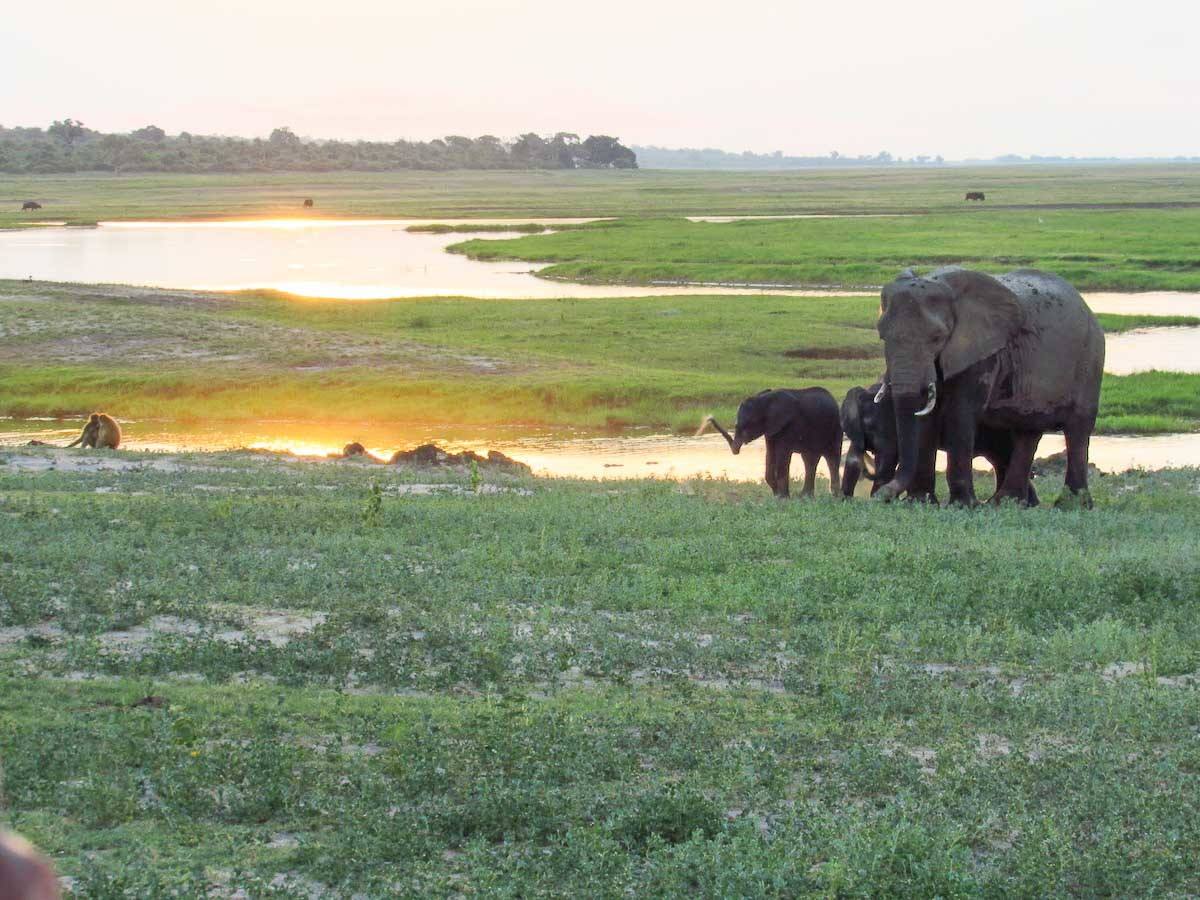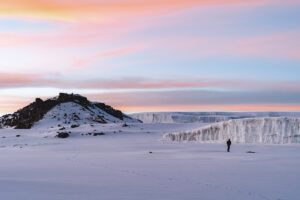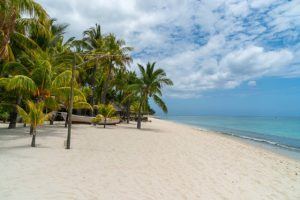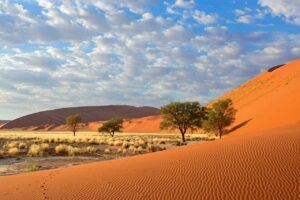Some of our links are affiliated, we will earn a commission when you buy a service or product. This will have no extra cost for you. For further info please refer to our Privacy Policy
Botswana is one of the best countries in Africa for a safari, but if you want to have an unforgettable experience, you must know the best time to go to Botswana for each activity. And I’m here to help you with that!
The diversity of wildlife that can be found in Botswana safari and its extraordinary panoramas are what dreams are made of.
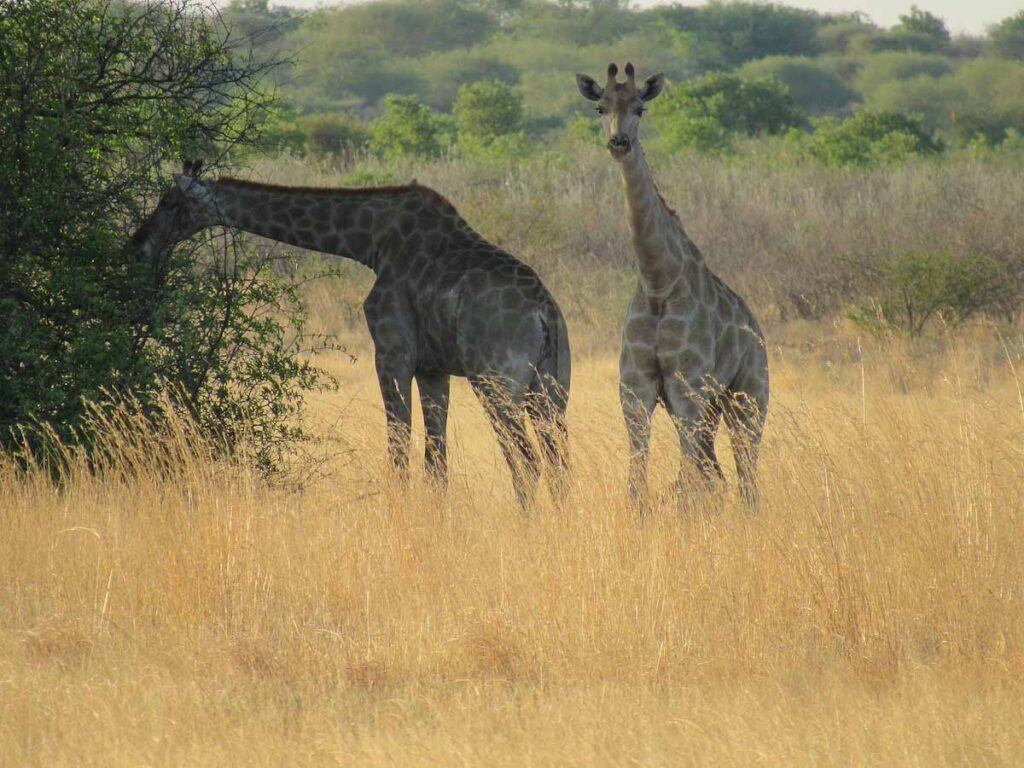
Consider the iconic Okavango Delta. It offers unparalleled wildlife viewing opportunities in a unique, wetland environment. It’s also home to the iconic Kalahari Desert.
Plus, Botswana’s commitment to sustainable and low-impact tourism is beyond commendable. It helps ensure intimate and authentic safari experiences while maintaining the natural beauty and integrity of the country’s wilderness areas.
Not to mention that Botswana is one of the safest countries in Africa.
I travel to Botswana every chance I get, and I feel like I haven’t even scratched the surface of what there is to see here.
But to get the most out of your trip, you’ll need to know the best time to visit Botswana. We’ve got that information for you here.
Spoiler alert: while there’s no bad time to travel to Botswana, some times are better than others.
Botswana Travel Tips
If you are in a hurry here is a summary of what you need to plan your Botswana trip:
- The best time to go to Botswana: the popular time is between May and October, during the dry season. But keep reading to choose the best time to visit Botswana for each activity and experience you want to have.
- Find the best flights to Botswana via Skyscanner
- For accommodation, you can find the best hotels and lodges in Botswana on Booking.com
- For safaris and day trips check our GetYourGuide Botswana tours.
The best time to go to Botswana: understanding the seasons
Botswana is known for its stunning wildlife and unspoiled wilderness. It offers you a unique experience from other African destinations, due to its varied ecosystems. Iconic wetlands that drain into the famous Kalahari Desert equals a fascinating trip!
Understanding the country’s seasonal dynamics is important to planning the perfect safari or exploration.
Here, we’ll break down the best times to visit based on weather, wildlife, region, and tourist seasons.

Botswana High Season (July to October)
The peak season in Botswana coincides with the dry winter months, from July to October. During this time, the weather is generally dry and mild, making it an excellent time for wildlife viewing.
Animals gather around the few remaining water sources, making them easier to spot. The Okavango Delta, in particular, is a spectacular sight as the floodwaters arrive, attracting an abundance of wildlife.
This is also the busiest season, though, so expect higher prices and more crowded safari lodges.
Botswana Low Season (December to March)
The wet summer months, or the rainy season, is from December to March. Botswana’s Summer rains are also known as the ‘Green Season.’ Although the rains can be heavy, they usually don’t last all day.
The landscape transforms into a lush, green paradise, which is perfect for the birds – and bird watchers! It’s also great for anyone who prefers a more solitary experience.
Apart from the migratory birds, wildlife viewing can be a bit more challenging due to the thick lush vegetation. Plus, animals are less concentrated around water sources. You’ll notice, too, a higher concentration of pesky mosquitoes.
But, the wettest months are also when rates are at their lowest, and you can enjoy the beauty of Botswana without the crowds.
Botswana Shoulder Seasons (April to June and November)
There are two shoulder seasons, which coincide with what you might think of as fall and spring. These are April to June and November.
These months are times of transition between the extremes of the high and low seasons. In April and May, the landscape is still green, but the heavy rains have stopped, making it easier to get around and spot wildlife.
June is the beginning of the dryer winter months, with cooler temperatures and excellent wildlife viewing opportunities.
November is a bit of a wildcard. It can be hot and dry like the winter months, or it can see a preview of the summer season rains.
These months offer a great balance between good wildlife viewing, fewer tourists, and moderate prices.
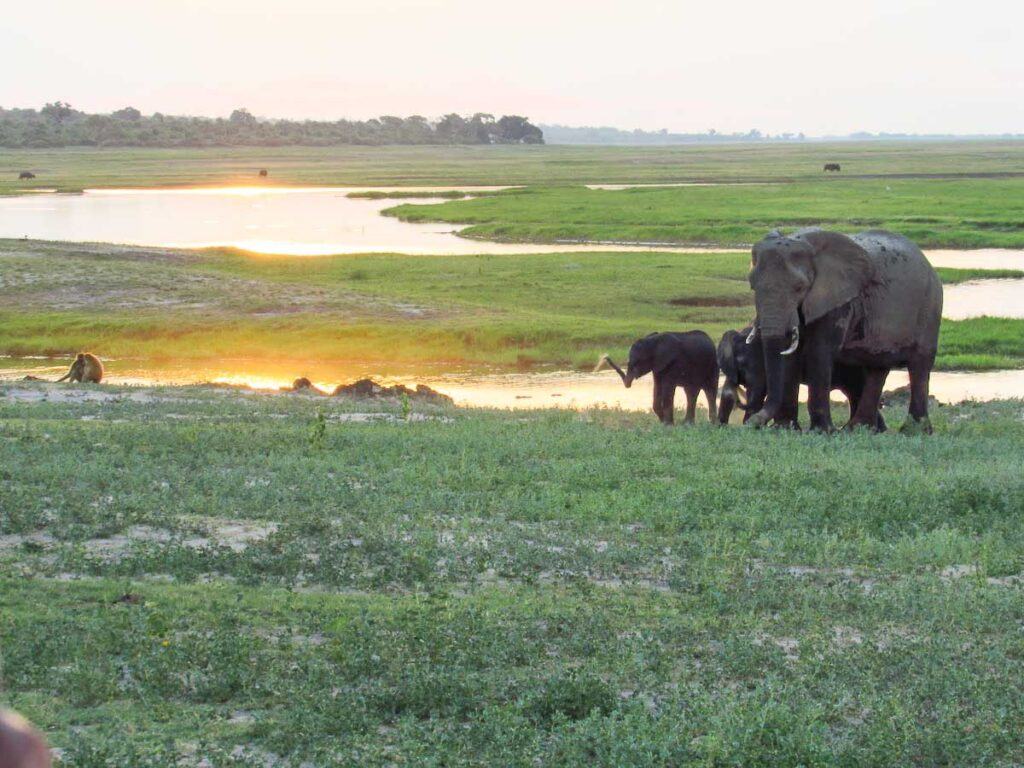
Botswana Weather Considerations
The worst weather in Botswana is typically during the height of the rainy season. In January and February, the heavy downpours can limit wildlife viewing and make some roads impassable.
Some lodges and camps may close temporarily or for the season, too.
On the other hand, the best weather is often found from May to September. The days are warm, and the nights are cool, providing comfortable conditions for game drives, safari walks, and other activities.
With the pleasant weather is easier to sleep during the cooler nights, as well, if your accommodation doesn’t have air conditioning.
The best time to visit Botswana really depends on what you want from your trip.
For the classic safari experience with abundant wildlife viewing, the dry winter months with sunny weather are perfect.
Or, if you’re a bird lover or are looking for a more budget-friendly and less crowded experience, the Green Season could be ideal for you.
The shoulder months are a balance, combining good wildlife sightings with fewer travelers.
The truth is, Botswana’s appeal lies in its untouched wilderness and variety of wildlife – a true year-round spectacle!
The Best times to visit Botswana’s favorite destinations
Each of these destinations in Botswana is a unique adventure. The experience of visiting each one varies a lot depending on the season.
These places cater to different interests, from bird watching and game drives to seeing the dramatic transformations of the landscape.
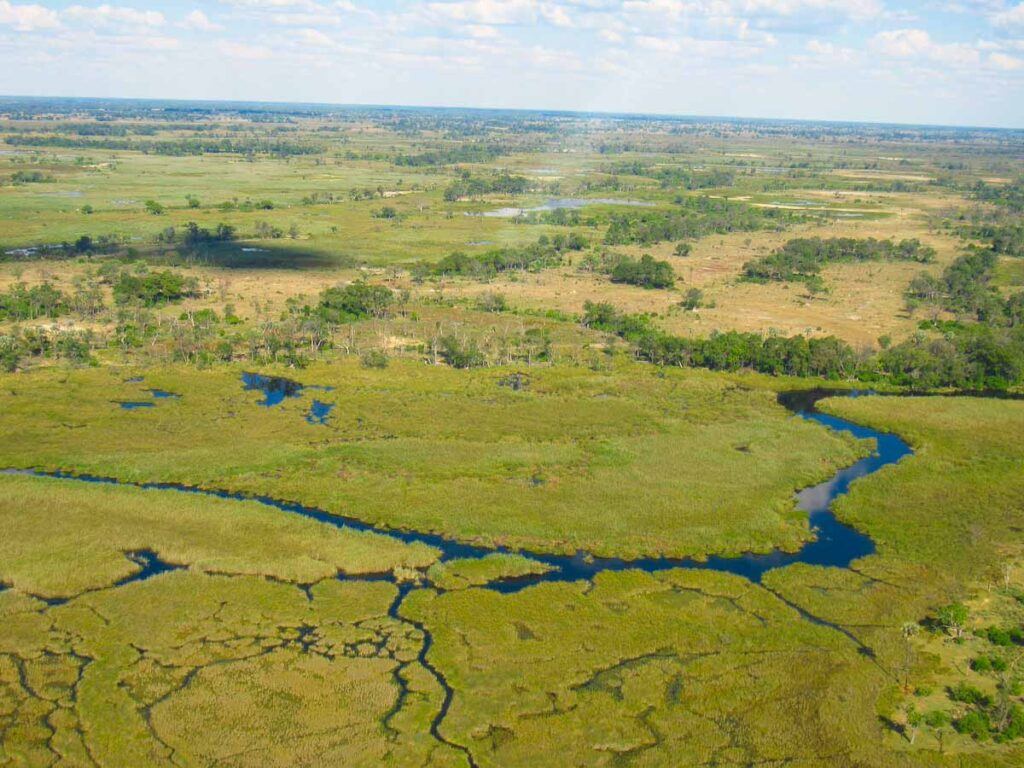
1. Okavango Delta
The best time to visit the Okavango Delta is during the dry season, from May to October. This period coincides with the floodwaters descending from Angola, which transform the Delta into a lush animal habitat.
Animal spotting is at its peak, as animals congregate around the water holes. As well, the weather is relatively cool and dry.
2. Chobe National Park
For Chobe National Park, the most favorable time is also during the dry winter season, between May and October. This is particularly true for the Chobe Riverfront area, accessible from the town of Kasane. Here large herds of elephants and other wildlife are easily seen.
The dry months provide excellent game viewing opportunities as animals gather around the river and floodplains.
3. Makgadikgadi Pans
In contrast, the best time to visit the Makgadikgadi salt Pans is during the wet season, from November to March. This is when the pans (empty lake beds) fill with water, attracting a spectacular variety of birdlife.
This season also signals the annual zebra migration. The landscape turns lush and green, offering a different experience from the typical dry safari.
However, the meerkats that populate this area may not be as easily seen in the rainy season. Prime time to observe these little characters is from April to October, but November could offer some good sightings.
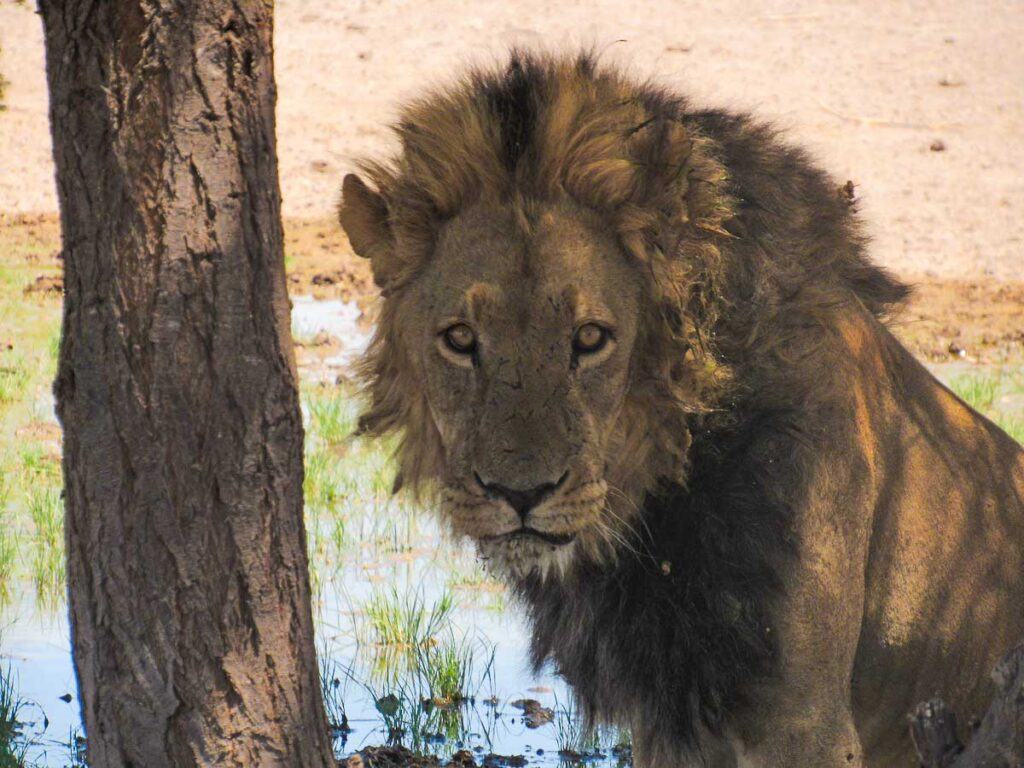
4. Kalahari Desert
The Kalahari Desert, which covers the majority of Botswana, is best visited in the wet season as well, particularly from December to April. During this time, the desert comes to life with fresh grasses and water pools.
The new food and water sources attract wildlife such as springbok, gemsbok, and of course predators. This is also when the desert experiences a flush of color with its unique plant life. It’s stunning to see!
5. Central Kalahari Game Reserve
The Central Kalahari Game Reserve is part of the greater Kalahari Desert. However, it’s a more defined and protected area focused on conservation and tourism.
It features a different and more wildlife-rich experience compared to the broader expanse of the Kalahari Desert. As a result, the best time to visit this area is a bit different.
The ideal time to explore the Central Kalahari Game Reserve is towards the end of the wet season, around February to April. This period has better wildlife viewing as animals are drawn to the pans that fill with water here.
The landscape is lush, and the moderate temperatures are more comfortable compared to the heat of the peak summer months.
The Okavango Delta During Full Flood
The full flood in the Okavango Delta is a wonder all of its own. The flood typically occurs fairly early in the dry season, between June and August. This seasonal flooding is due to rainfall in the Angolan highlands during the wet season.
The waters travel down the swollen Cubango River, south to where it becomes the Okavango River, and into the delta.
The peak of the flood varies each year depending on the rainfall patterns, but it generally reaches its highest water level during these months.
This annual event transforms the landscape dramatically and has a significant effect on wildlife patterns in the region. The rising waters bring life to the region, attracting an abundance of animals and increasing the bird population.
These changes make it an ideal time for birdwatchers and nature lovers. This influx of water also encourages some wildlife species to move into the delta to take advantage of the water and greenery.
High water in the Okavango Delta also means that conditions are perfect for exploring the waterways by mokoro, a traditional carved canoe.
Botswana seasonal temperatures
| Region/Area | Season | Average High Temperature (°C) | Average Low Temperature (°C) |
| Okavango Delta | Dry (May-Oct) | 30.2 | 13.2 |
| Wet (Nov-Apr) | 32.9 | 19.8 | |
| Chobe National Park | Dry (May-Oct) | 30.0 | 13.0 |
| Wet (Nov-Apr) | 31.3 | 19.0 | |
| Makgadikgadi Pans | Dry (May-Oct) | 26.0 | 7.0 |
| Wet (Nov-Apr) | 34.0 | 17.0 | |
| Central Kalahari Game Reserve | Dry (May-Oct) | 28.5 | 6.0 |
| Wet (Nov-Apr) | 36.0 | 17.0 |
Notes about Botswana weather:
- The dry season tends to see a fairly big change between day and night time temperatures. You’ll experience cooler temperatures at night and warm/hot during the day.
- The rainy season is warm at night as well as during the day, with the hottest weather, higher humidity, and more frequent rain.
- Temperatures can vary widely between day and night in the Kalahari Desert, especially in the Central region.
- Remember that the weather in Botswana, like weather anywhere, can be unpredictable. Droughts happen, and the start and end times of the seasons aren’t carved in stone. But every season is beautiful in Botswana.
Travel Advice:
Don’t forget your Travel Insurance! You don’t want anything to ruin your trip, right? So don’t take the risk! Reliable travel insurance can help you in case of travel issues, from accidents to health problems, travel delays, and lost luggage.
There are many insurances in the market, our picks are HeyMondo and SafetyWing. We used both and always had a good experience. Click on the insurance names to get a quote.
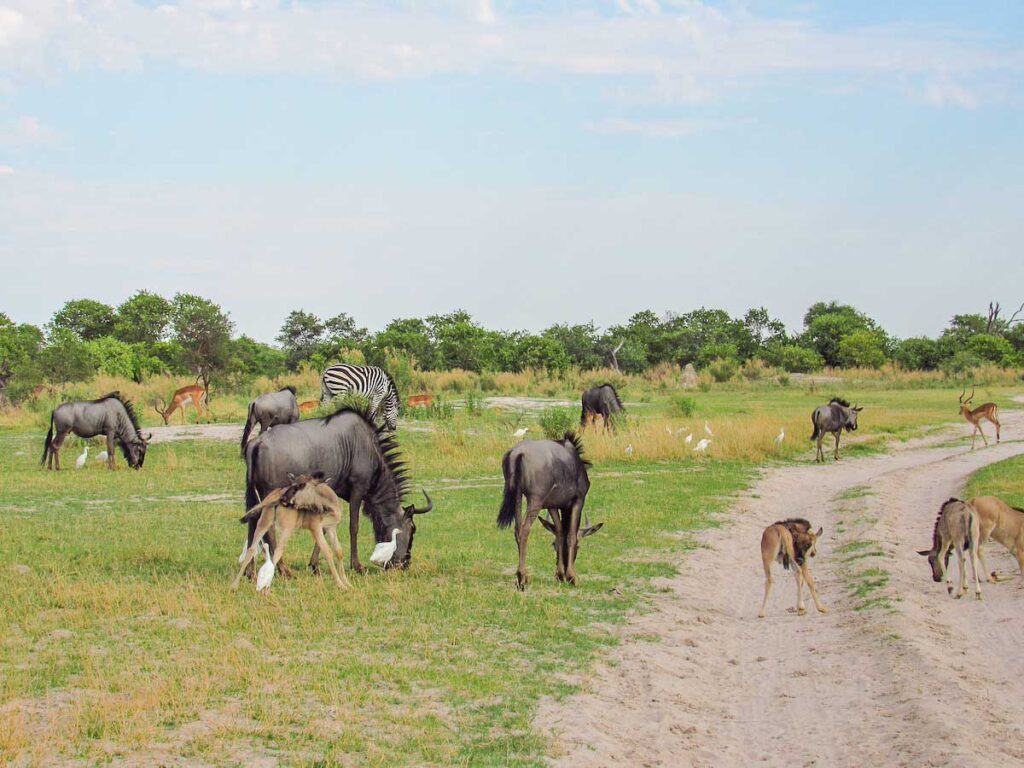
Botswana’s Annual Migration
Mentioned above is Botswana’s annual zebra and wildebeest migration. Though smaller and less well-known than the Great Migration in East Africa, it’s no less than a spectacular sight. Here are the key details about this incredible natural phenomenon:
➤ Timing and Route:
- The migration primarily occurs in the Makgadikgadi and Nxai Pan National Parks, typically starting around the beginning of the rainy season in November and continuing through to March or April.
- The migration follows the rains, with the zebras and wildebeests moving in search of fresh grazing grounds. The animals typically start their journey from the Boteti River region and move towards the fresh grasslands of the Makgadikgadi and Nxai pans.
➤ Scale of the Migration:
- The number of animals involved in this migration varies, but it can include tens of thousands of zebras along with a smaller number of wildebeests and other herbivores.
- This migration is considered to be the second-largest zebra migration in Africa, with estimates of around 25,000 to 30,000 zebras participating. It’s a wildlife photographer’s dream.
➤ Ecological and Environmental Significance:
- This migration is crucial for maintaining the ecological balance of the region. The movement of these large herbivores helps to fertilize the land, disperse seeds, and maintain the grasslands.
- The migration also supports a variety of predators, including lions, cheetahs, and hyenas, which follow the herds for hunting opportunities.
➤ Challenges and Threats:
- The migration faces several challenges, including habitat fragmentation, human-wildlife conflict, and changes in land use.
- Water availability is also a critical factor that influences migration patterns. Changes in rainfall patterns due to climate change pose potential threats to the wildlife.
➤ Tourism and Viewing Opportunities:
- This migration offers a terrific opportunity for wildlife lovers and photographers. The perfect time to witness the migration is from December to March.
- The region is less crowded compared to more famous safari destinations.
- You’ll therefore have a more intimate and unique wildlife viewing experience.
➤ Cultural Impact:
- The migration is not only important for wildlife but also holds cultural significance for local communities. These people have coexisted with these migratory patterns for generations, and they affect many of their traditions and routines.
The migration of zebra and wildebeest in Botswana is a remarkable event. It displays the dynamic and interconnected nature of ecosystems in a very tangible way.
It also highlights the importance of preserving natural migration corridors and encouraging sustainable tourism practices to maintain this spectacular, wild event.
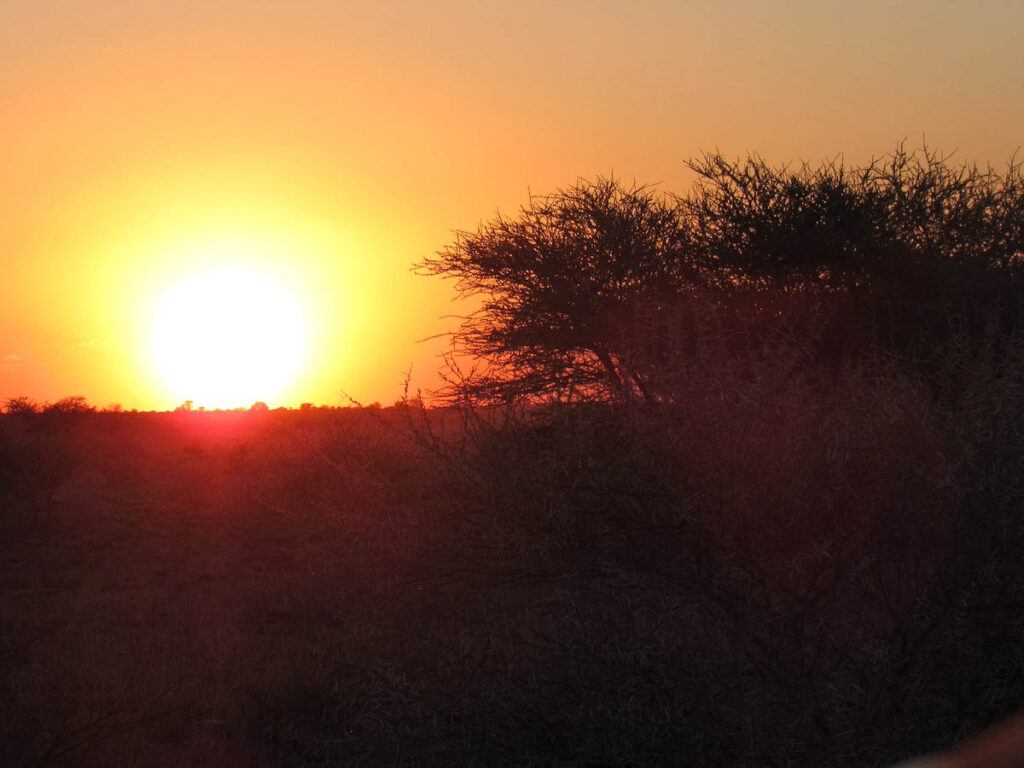
When is the best time to travel to Botswana?
The short answer to this question is that the best time to go to Botswana is between May and October, during the dry season. But as you can see, choosing the best time to visit Botswana really depends on personal preferences and the experiences you’re looking for.
The country’s range of destinations, each with its unique weather patterns and wildlife activities, offer great experiences throughout the year.
Whether it’s witnessing the Okavango Delta in full flood, exploring the arid beauty of the Kalahari, or avoiding the tourist rush, understanding Botswana’s seasonal changes is the key to planning your ideal adventure.
Finding the balance between these three aspects of Botswana travel will help you make the absolute best of your Africa experience.
Author: Deb Hendricks
Deb’s been traveling since guidebooks were our only source of info, and has never found a place that didn’t fascinate her. But Africa is the only place she returns to over and over again; nowhere else has more to offer a traveler. She hopes that by writing about it she will inspire you to experience Africa for yourself. It’s the adventure of a lifetime!

